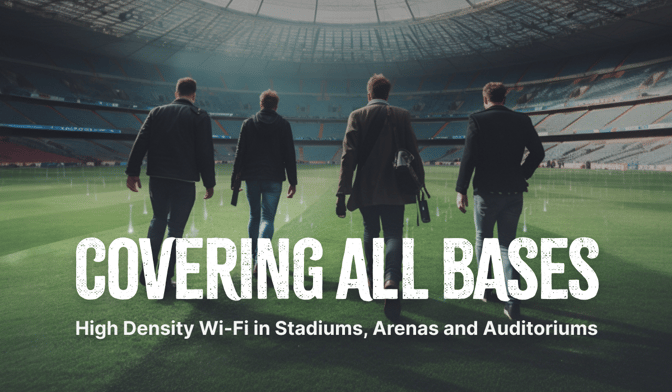Webinar Recording - Covering all Bases I High Density Wi-Fi in Stadiums, Arenas and Auditoriums

On July 13, 2023, the crowd went wild over the next installment of "Dwell Time!" Ok, sorry about that - we promise no more terrible jokes about crowds or sports in this blog post.
Anyway, if you missed the show, don't worry, we've got you covered. You can now check out the recording here!
Recap:
Our hosts: Jerry Olla, Joel Crane and Jussi Kiviniemi
The expert guests: Ben Toner, Chris Reed and Dan Jones

Here are some of the key takeaways!
Design Considerations
- A high-density Wi-Fi environment is any relatively small area with a lot of users.
- Stadium environments change a lot, depending on the space, and the initial use is unlikely to be the only use.
- Roaming management is crucial for multi-level spaces to avoid undesired client associations.
- Bandwidth demands usually start high, but end up being much lower per user in the real world.
- The number of clients per radio is typically around 75 (YMMV), but also consider that not all clients are active simultaneously.
- In public venues, users often enable battery saving mode, which might switch the client from 2 spatial streams to 1, which changes what data rates the client can access.
- Much of the client traffic might be background tasks like iCloud photo uploads.
- Avoid using 2.4 GHz for guest access, prefer 5 GHz or 6 GHz.
- The client device is always making choices in Wi-Fi association; consider their behavior in the design.
- There's no universal solution for all stadium Wi-Fi design challenges.
Physical Design Constraints
- Talking to stadium staff or those who work there regularly is critical to understanding specific needs, usage patterns, cabling, and mounting constraints.
- AP placement depends on the architectural constraints, such as overheads, handrails, and under-seat placements.
- Antenna selection varies across different areas in the stadium. For example, you might use omnis in concourse areas, and overheads or under-seat APs in the seating.
- Under-seat APs are easy to access and service.
- Over-head APs can be expensive and difficult to service.
- Design strategy should usually prioritize density over coverage, containing cells to make them smaller.
Stadium Personas and Configurations
- Stadiums tend to have three personas: primary use (football, soccer, baseball), concert events, and half-full scenarios for youth games or other events.
- Different configurations and operational manuals are necessary for each use case.
- Grouping APs based on location or seating areas can help manage different configurations.
Crowd Attenuation and Modeling
- Dang it, we need some marketing material in here. Uhhhh... In Hamina Network Planner Plus, crowd attenuation can be modeled in planning, considering the height and attenuation from seats. There, that'll work. Consider yourself "marketed to".
- Keep an eye out for reconfigurable stadiums with changing seating arrangements.
- The first event is a crucial tuning exercise, requiring adjustments from the aisles and empty seats.
Got a stadium, arena or auditorium that needs Wi-Fi? You’ve come to the right place - our tools can design & survey Large Public Venue Wi-Fi all day long without breaking a sweat. If you'd like to see more first, no problem! Schedule a demo here with one of our product experts.
Never miss an episode of Dwell time - sign up for our webinar info here: